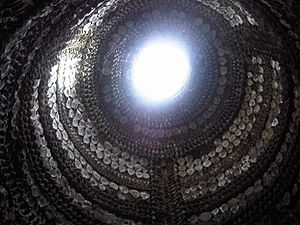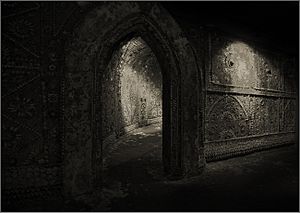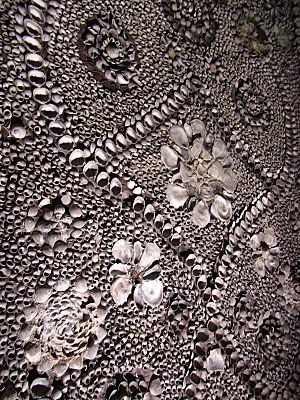Shell Grotto, Margate facts for kids
The Shell Grotto is a super cool underground tunnel in Margate, Kent. It's like a secret passage! Almost every part of its walls and ceiling is covered in beautiful mosaics made completely from seashells. Imagine, there are about 4.6 million shells, covering an area of 2,000 square feet (185 square meters)!
This amazing place was found in 1835. But here's the mystery: nobody knows exactly how old it is or why it was built. The Shell Grotto is a very important historical site, called a Grade I-listed building. You can visit it today!
Contents
What is the Shell Grotto?
The Shell Grotto is a long, winding underground path. It's about 8 feet (2.4 meters) tall and 70 feet (21 meters) long. At the end, you'll find a rectangular room called the Altar Chamber. This room is about 15 by 20 feet (4.5 by 6 meters) in size.
You enter the grotto by going down some steps. The path starts as a narrow tunnel, dug out of chalk. It twists and turns until you reach an archway. From this archway onwards, the walls and ceiling are completely covered in shell mosaics!
Exploring the Shell Passages
The arch leads into a circular area called the Rotunda. From here, you can see the Dome, which is a shaft that goes up to the surface. It lets in some daylight, making the shells sparkle. The Dome's base is shaped like a triangle, and it has an arch on each side. Two arches lead from the Rotunda, and one leads into the Serpentine Passage.
The Serpentine Passage is full of curving walls and arched ceilings. It's decorated with many different shell mosaic patterns. At the end of this passage, another arch leads into the Rectangular Chamber. Here, the shell designs become more formal and geometric. You'll see shapes like stars and suns. The main feature in this room is a curved alcove, known as the "altar."
The Mystery of Its Purpose
No one truly knows why the Shell Grotto was built. People have many ideas! Some think it was a rich person's "folly" (a fancy building built just for fun) in the 1700s or 1800s. Others believe it might be a very old calendar, used to track stars thousands of years ago. Some even connect it to ancient groups like the Knights Templar or Freemasonry.
In 2007, a domed cave was found in Rome with similar shell mosaics. This made some people wonder if the Shell Grotto could have been built by the Phoenicians. They were an ancient people who founded many colonies around 3,000 years ago.
Where Did the Shells Come From?
Most of the shells used in the mosaics are common types like mussels, cockles, whelks, limpets, scallops, and oysters. These shells could have been collected from nearby bays like Walpole Bay, Pegwell Bay, Sandwich Bay, or Shellness on the Isle of Sheppey.
However, a lot of the background in the mosaics is made from a shell called the flat winkle. This shell is not very common in the local area. It's much more common on shores west of Southampton. This suggests that these specific shells might have been brought from further away.
Today, there's also a modern museum and a gift shop attached to the grotto.
How Was It Discovered?
There are a few different stories about how the Shell Grotto was found, but most agree it happened in 1835. One of the earliest mentions of its discovery was in a newspaper article from May 9, 1838.
The article said that a gentleman bought a house called Belle Vue cottage. He was having some work done, and during the digging, workers hit a large stone. The gentleman looked closely and found a huge grotto! It was completely covered in shells arranged in amazing patterns. The article said it was one of the most curious sights imaginable and must have been built by torchlight. The owner planned to open it to the public soon.
The Shell Grotto has been privately owned ever since its discovery.
Keeping the Grotto Beautiful
In 1932, a new owner took over. They replaced the old gas lighting with electric lights. The gas lights had made the shells turn black over many years. Cleaning tests show that most of the shells have lost their original colors under the dirt and are now white.
The grotto has also had problems with water getting inside. However, after a five-year project with English Heritage, it was removed from the "Heritage at Risk Register" in 2012. This means it's much safer now! A special project called "The Roundel Project" was started in 2012 to help replace some of the mosaic panels.
In 2008, a group called "The Friends of the Shell Grotto" was formed. This group is a non-profit trust. Their goal is to help promote, protect, and save the grotto as a truly unique historical monument for everyone to enjoy.




